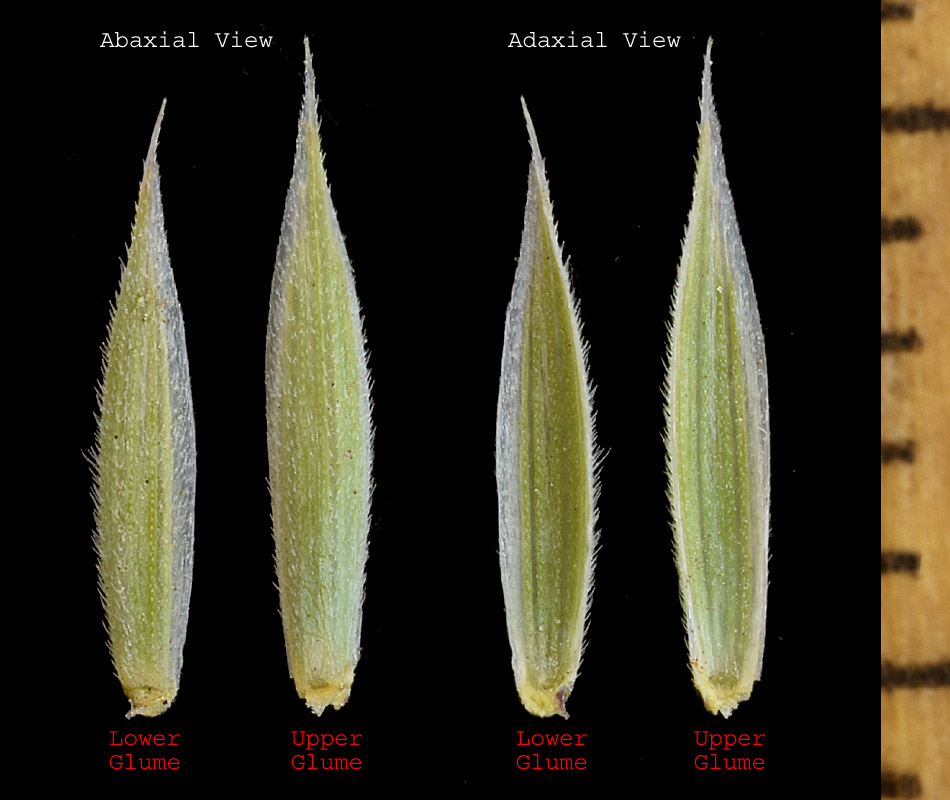Pascopyrum smithii

Western Wheatgrass
Glumes
Douglas
Provincial Park
17-June-2025
Note
the glumes are widest at or near the base, not widening at midlength or beyond.
Many glumes, particularly the lower ones, are curved with one side tracing a
gentle S curve while the other side is straighter. There is often no clear
mid-nerve extending all the way to the apex. Note that these glumes are less
curved than the first two specimens on this web site.
The following items are taken from keys in Flora
of Saskatchewan, Fascicle 4, Grasses of Saskatchewan by Anna L. Leighton and
Vernon L. Harms. Family Poaceae is first divided into tribes, then the
tribes are divided into genera, and the genera divided into species.
However, there are a number of tribes that are very difficult to distinguish
morphologically. These are grouped into a large, artificial tribe I call
"Multitribe". Multitribe is then divided into groups, and each
group is then divided into genera. The answers are in the order you would
normally work through the keys.
 | Triticeae: Answers to key questions
leading to this tribe.
 | Mature inflorescence, if breaking into units, then the units not as
below; NOT [Mature inflorescence breaking into spikelet units consisting
of a sessile fertile spikelet, a hairy pedicel with or without a sterile
spikelet at tip, and a hairy rachis joint, all arising at the same point
(a node) in specialized panicle branches called rames] |
 | Spikelets not as below; sterile florets if present, either located
distal to the fertile floret(s) on the rachilla or paired and attached
at the base of a single fertile floret, not paired with the upper glume
as below; lemma and palea variously textured, enclosing the flower or
not; disarticulation usually above the glumes; NOT [Spikelets usually
dorsally compressed, appearing 1-flowered but containing 1 fertile
floret and 1 sterile floret, the latter attached to the base of fertile
floret opposite the upper glume, resembling the upper glume, and
together with the upper glume enveloping the fertile floret; lower
glumes minute (sometimes absent) to 3/4 as long as upper glumes and
typically wrapping most of the way around the pedicel at base; fertile
floret seed-like with chartaceous-indurate lemma and palea enclosing
flower and fruit; disarticulation below the glumes with rare exceptions] |
 | Spikelets 1 to many-flowered, subtended by a pair of glumes (only 1 on
lateral spikelets in Lolium); palea margins enclosed or not; plants of
dry or wet habitats; NOT [Spikelets 1-flowered, lacking glumes; margins
of the palea tightly enclosed by the lemma margins on female or perfect
florets; plants of wetlands, often emergent aquatic] |
 | Inflorescence a terminal spike with sessile or subsessile spikelets
attached broadside at nodes on opposite sides of the rachis; NOT
[Inflorescence not as above; if a terminal spike, then the lateral
spikelets attached edgewise to the rachis with inner (upper) glume
wanting (as in Lolium)]
|
|
 | Pascopyrum: Answers to key questions
leading to this genus.
 | Spikelets 1 per node, occasionally 2 at some nodes; NOT [Spikelets 2 or more per node, occasionally 1 at some
nodes] |
 | Spikes not pectinate with spikelets not arranged as below; spikelets
usually appressed to ascending, sometimes somewhat divergent; glumes
usually flat at base, sometimes keeled towards tip; NOT [Spikes usually
pectinate with spikelets closely-set, regularly-spaced and parallel like
the teeth of a comb; spikelets divergent at angles of 30° to 90° from
the rachis at maturity; glume keels prominent to base] |
 | Introduced or native perennials;
NOT [Introduced annuals rarely found outside cultivation or
plantings] |
 | Glumes and lemmas not particularly thick-textured and rigid, the
apices acute, acuminate or awned; plants native or introduced, uncommon
to very common in SK; NOT [Glumes and lemmas distinctly thick-textured,
rigid and usually blunt- tipped (glumes sometimes mucronate, lemmas
occasionally awned); plants introduced, rare in SK] |
 | Lemmas unawned or with awns straight or somewhat flexuous; if awns
strongly outcurving, then at midspike the spikelets twice as long as the
rachis internodes or longer and extending beyond 2 nodes, and the lemmas
usually pubescent; NOT [Lemma awns strongly outcurving; at midspike the
spikelets the same length as the rachis internodes or 1.5 times as long
and extending into the middle of the next internode; lemmas glabrous] |
 | Glumes widest at or near base, not widening at midlength or beyond; the
longer glume about as long as the lowest lemma; leaf blades to 4.5 mm
wide, stiff, usually glaucous, tapering to a sharp point, usually angled
away from the culm at a ± fixed angle approaching 45°; the prominently
ridged adaxial surface markedly different from the ± smooth abaxial
surface; plants with creeping rhizomes; NOT [Plants without the above combination of characteristics: if the glumes
as above then the leaf blade surfaces not markedly different] |
|